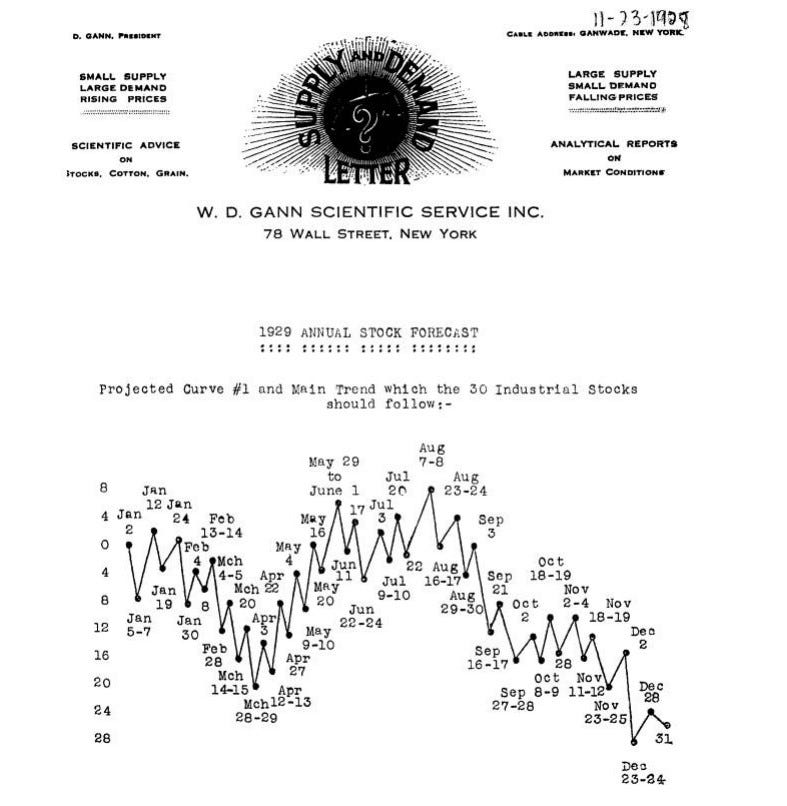Law of Vibration by W.D. Gann (Part 3)
Faith or Mystery? The Law of Vibration is not a science but a concept that Gann discovered that is applicable to anything moves. In this piece, final part of the Law
This is the third and final part and is one of the most important and fascinating accounts of W.D. Gann's techniques and discoveries. Enjoy your reading!
As the examples from Ticker interview show, around 1909 Gann was employing his Law of Vibration to precisely forecast stock and commodity prices up to several months forward. However starting around 1915, Gann produced and sold annual forecasts of the stock and commodity markets. Although Gann produced these annual forecasts up to his death in 1955, relatively few survive. Nevertheless, from the surviving annual forecasts, it appears that Gann produced them in exactly the same way as he had produced his earlier shorter-term forecasts; namely based on the Law of Vibration.
Gann’s Annual Forecasts
One particularly accurate annual forecast was Gann’s 1929 stock market forecast. In summary, the forecast was completed and distributed on November 23, 1928, and included a description of the general outlook for 1929. This year occurs in a cycle that shows the ending of the bull market and beginning of a prolonged bear campaign. Fact that it has run longer and prices have advanced to such abnormal heights means when the decline sets in it must be in proportion to the advance. The year 1929 will witness some sharp, severe panicky declines in many high-priced stocks. A projected graph or chart of the Dow Jones Industrial Average forecasts this index would peak on August 7, 1929, and then starts a major downtrend for the rest of the year.
A projected graph or chart of the Dow Jones Railroad Average forecasts this index would peak on August 8 or 9, 1929, and then start a major downtrend for the rest of the year. Although it should be noted that Dow Jones Industrial Average and Dow Jones Railroad Average both peaked on September 3, 1929, overall Gann’s annual stock market forecast for 1929 was highly accurate. Moreover, from a careful examination of Gann’s 1929 stock market forecast, it is possible to discern further principles of the Law of Vibration. These principles are as follows.
Although the Law of Vibration comprises a number of elements, time factor is the most important. More specifically, throughout his career Gann used the term «Time Factor» as a substitute or synonym for astrological influences. Therefore astrological influences are the most important element in the Law of Vibration. Time given for tops and bottoms is the most important factor for you to know and watch. It makes no difference about the price a stock is selling at. So long as you know when it will reach low or high levels you can buy or sell and make money. Remember you must buy and sell at right time regardless of prices. No matter how high stocks are, if they are going higher, you should buy. It makes no difference how low they are; if trend is down and they are going lower, you must sell short and go with the trend.
In applying the Law of Vibration to the stock market, it is important not only to assess the astrological influences but also internal vibrations of a stock. For example, assume that during a general stock market uptrend there is a short-term correction and most stocks fall in price. If during that period of time, a particular stock merely moves sideways, rather than falls, it indicates the internal vibrations of stock are especially strong and therefore it will subsequently perform strongly when the overall uptrend is resumed. The Dow Jones 30 Industrial stocks are representative of the active industrials and most of them will follow the Industrial Curve very closely. But some of the individual stocks that are in strong or weak position will vary from this curve and make tops and bottoms at different times. These special stocks and their position will be covered in the supplements each month.
Stocks and commodities typically don’t switch from an uptrend to a downtrend until their rate of vibration has slowed down. This reduction in the rate of vibration can be observed as prices move sideways over time to lower Gann angles. The ones that make top in the early part of the year and fail to reach higher levels in July or August will be the ones to lead the decline, because they will have had longer time for distribution. Guard against selling short the late movers until they have had time to complete distribution. It is important to note that although for many years Gann produced and sold annual forecasts of the stock and commodities markets, he didn’t intend for his subscribers to rely on these alone. Indeed, Gann recognised the importance of his subsequent monitoring of these markets and his regular updates. Consequently, Gann issued supplements, or updates, three times each week by means of his «Supply And Demand Letter», which he described as follows.
People often write for my opinion on Baldwin, US Steel, General Asphalt or some special stock. I judge the stock by the position of time and volume as it is today. If in a few days, I see a large amount of volume, up or down, I change my position, so it is not always what I think of a stock today, but what I‘m going to think of it later that counts. That is why I issue a tri-weekly letter because the market changes and I can advise my subscribers to change their position and protect themselves against losses. If market never reversed its trend, there would be no need of a tri-weekly letter. In the practical application of the Law of Vibration, time factor, or astrological influences are the most important element. Consequently, in preparing his annual forecasts, Gann was required to assess numerous astrological influences over the subsequent year.
Assessing months in advance how strong astrological influences will be and how long they will remain in force is a complex task prone to error on occasion. Gann found it necessary to issue regular letters to his subscribers in order to clarify and correct his annual forecasts when necessary, as well as to identify particular stocks and commodities were especially strong or weak. Therefore, at a fundamental level, Gann was constantly forecasting and monitoring external vibrations and internal vibrations.
Questa è la terza ed ultima parte ed è uno dei racconti più importanti e affascinanti tra le tecniche e scoperte di W.D. Gann. Buona lettura!
Come mostrano gli esempi tratti dall'intervista di Ticker, intorno al 1909 Gann utilizzava la sua Legge della Vibrazione per prevedere con precisione i prezzi delle azioni e delle materie prime fino a diversi mesi prima. Tuttavia, a partire dal 1915 circa, Gann produsse e vendette previsioni annuali sui mercati azionari e delle materie prime. Sebbene Gann abbia prodotto queste previsioni annuali fino alla sua morte, avvenuta nel 1955, ne sono sopravvissute relativamente poche. Tuttavia, dalle previsioni annuali sopravvissute, sembra che Gann le abbia prodotte esattamente nello stesso modo in cui aveva prodotto le sue precedenti previsioni a breve termine, ossia basandosi sulla Legge della Vibrazione.
Le previsioni annuali di Gann
Una previsione annuale particolarmente accurata fu quella di Gann per il mercato azionario del 1929. In sintesi, la previsione fu completata e distribuita il 23 Novembre 1928 e comprendeva una descrizione delle prospettive generali per il 1929. Quest'anno si inserisce in un ciclo che mostra la fine del mercato toro e l'inizio di una prolungata campagna orso. Il fatto che sia durato più a lungo e che i prezzi siano saliti a livelli così anormali significa che quando il declino arriverà dovrà essere proporzionale all'avanzata. L'anno 1929 sarà testimone di forti e gravi ribassi da panico in molti titoli ad alto prezzo. Un grafico previsionale del Dow Jones Industrial Average prevede che questo indice raggiunga il picco massimo il 7 Agosto 1929, per poi iniziare un'importante tendenza al ribasso per il resto dell'anno.
Un grafico o una proiezione del Dow Jones Railroad Average prevede che questo indice raggiunga il picco l'8 o il 9 Agosto 1929, per poi iniziare un'importante tendenza al ribasso per il resto dell'anno. Sebbene si debba notare che il Dow Jones Industrial Average e il Dow Jones Railroad Average raggiunsero entrambi il picco il 3 Settembre 1929, nel complesso le previsioni annuali di Gann sul mercato azionario per il 1929 furono molto accurate. Inoltre, da un attento esame delle previsioni di Gann per il mercato azionario del 1929, è possibile individuare ulteriori principi della Legge della Vibrazione. Questi principi sono i seguenti.
Sebbene la Legge della Vibrazione comprenda una serie di elementi, il fattore tempo è il più importante. In particolare, per tutta la sua carriera Gann ha utilizzato il termine «fattore tempo» come sostituto o sinonimo delle influenze astrologiche. Pertanto, le influenze astrologiche sono l'elemento più importante della Legge della Vibrazione. Il tempo dato per i top e i bottom è il fattore più importante da conoscere e osservare. Non fa differenza il prezzo di vendita di un titolo. Finché saprete quando raggiungerà livelli bassi o alti, potrete acquistare o vendere e guadagnare. Ricordate che dovete comprare e vendere al momento giusto, indipendentemente dai prezzi. Non importa quanto siano alte le azioni, se stanno salendo, dovete comprare. Non fa differenza quanto sono basse; se la tendenza è al ribasso e stanno scendendo, dovete vendere allo scoperto e seguire la tendenza.
Nell'applicare la Legge della Vibrazione al mercato azionario, è importante non solo valutare le influenze astrologiche ma anche le vibrazioni interne di un titolo. Ad esempio, supponiamo che durante un generale trend rialzista del mercato azionario si verifichi una correzione a breve termine e che la maggior parte dei titoli scenda di prezzo. Se in quel periodo un determinato titolo si limita a muoversi lateralmente, anziché scendere, significa che le vibrazioni interne del titolo sono particolarmente forti e che, quindi, avrà un'ottima performance quando riprenderà la tendenza generale al rialzo. I titoli del Dow Jones 30 Industrial sono rappresentativi dei settori industriali attivi e la maggior parte di essi seguirà molto da vicino la curva industriale. Tuttavia, alcuni dei singoli titoli che si trovano in una posizione di forza o di debolezza si discosteranno da questa curva e raggiungeranno i massimi e i minimi in momenti diversi. Questi titoli speciali e la loro posizione saranno trattati ogni mese nei supplementi.
In genere, le azioni e le materie prime passano da un trend rialzista a un trend ribassista solo quando il loro tasso di vibrazione è rallentato. Questa riduzione del tasso di vibrazione può essere osservata quando i prezzi si spostano lateralmente nel tempo verso angoli di Gann più bassi. Quelli che raggiungono il top nella prima parte dell'anno e non riescono a raggiungere livelli più alti in Luglio o Agosto saranno quelli che guideranno il declino, perché avranno avuto più tempo per distribuirsi. Non vendete allo scoperto i late mover finché non avranno avuto il tempo di completare la distribuzione. È importante notare che, sebbene per molti anni Gann abbia prodotto e venduto previsioni annuali sui mercati azionari e delle materie prime, non intendeva che i suoi abbonati si affidassero solo a queste. Infatti, Gann riconosceva l'importanza del suo successivo monitoraggio di questi mercati e dei suoi regolari aggiornamenti. Di conseguenza, Gann pubblicava supplementi, o aggiornamenti, tre volte alla settimana attraverso la sua «Supply And Demand Letter», che descriveva come segue.
Spesso mi scrivono per avere la mia opinione su Baldwin, US Steel, General Asphalt o qualche titolo particolare. Io giudico il titolo in base alla posizione del tempo e al volume di oggi. Se tra qualche giorno vedo una grande quantità di volumi, al rialzo o al ribasso, cambio la mia posizione, quindi non è sempre importante quello che penso di un titolo oggi, ma quello che penserò in seguito. Per questo motivo pubblico una lettera trisettimanale, perché il mercato cambia e posso consigliare ai miei abbonati di cambiare la loro posizione e proteggersi dalle perdite. Se il mercato non invertisse mai la sua tendenza, non ci sarebbe bisogno di una lettera trisettimanale. Nell'applicazione pratica della Legge della Vibrazione, il fattore tempo o le influenze astrologiche sono l'elemento più importante. Di conseguenza, nel preparare le sue previsioni annuali, Gann doveva valutare numerose influenze astrologiche per l'anno successivo.
Valutare con mesi di anticipo quanto saranno forti le influenze astrologiche e quanto a lungo rimarranno in vigore è un compito complesso e talvolta soggetto a errori. Gann riteneva necessario inviare regolarmente lettere ai suoi abbonati per chiarire e correggere le sue previsioni annuali, quando necessario, e per identificare particolari titoli e materie prime particolarmente forti o deboli. Pertanto, a livello fondamentale, Gann prevedeva e monitorava costantemente le vibrazioni esterne e le vibrazioni interne.
Conclusion
This paper has identified, or rediscovered, many of the elements of Gann’s Law of Vibration. However, the most important and difficult element is to identify and assess the past, present and future astrological influences on a stock or commodity. Consequently, the main goal of Gann researchers worldwide is to discover as much information as possible about that law. Indeed, correctly identifying true principles of astrology and the precise astrological influences impacting a particular financial market should perhaps be the focus of technical analysts in general who truly wish to extend the frontiers of technical analysis in the early twenty-first century.
Finally, the centenary of Gann’s discovery of the Law of Vibration, August 8 2008, was the starting date of the Olympic Games in Beijing, China. However, the ancient Greeks not only provided the world with Olympic Games, but also an early example of financial forecasting through correctly assessing astrological influences. More specifically, the Greek philosopher and mathematician Thales of Miletus (who lived from 625 to 547 B.C) provides this example. There is an anecdote of Thales the Milesian and his financial device, which involves a principle of universal application, but is attributed to him on account of his reputation for wisdom. He was reproached for his poverty, which was supposed to show that philosophy was of no use. According to the story, he knew by his skill in the stars while it was yet winter there would be a great harvest of olives in the coming year. So, having a little money, he gave deposits for the use of all the olive presses in Chios and Miletus, which he hired at a low price because no one bid against him.
When the harvest time came, and many wanted them all at once and of a sudden, he let them out at any rate he pleased, and made a quantity of money. Thus he showed the world that philosophers can easily be rich if they like. It appears the investment paradigm and methodology that Gann discovered approximately 100 years ago had in fact already been discovered and was in use some 2,500 years earlier. Faith or Mystery? The Law of Vibration is not a science but a concept that Gann discovered (according to him) that is applicable to anything moves. Truth or falsehood what is certain is that subject remains extremely fascinating to all students of the subject and Gann's techniques. Our advice is only one: don't believe, don't think, but act, study and prove yourself worthy. Every day.
Conclusione
Questo articolo ha identificato, o riscoperto, molti degli elementi della Legge di Vibrazione di Gann. Tuttavia, l'elemento più importante e difficile è l'identificazione e la valutazione delle influenze astrologiche passate, presenti e future su un titolo o una merce. In effetti, la corretta identificazione dei veri principi dell'astrologia e delle precise influenze astrologiche che impattano su un particolare mercato finanziario dovrebbe forse essere l'obiettivo degli analisti tecnici in generale che desiderano veramente estendere le frontiere dell'analisi tecnica all'inizio del XXI secolo.
Infine, l'8 Agosto 2008, centenario della scoperta della Legge di Vibrazione da parte di Gann, è stata la data di inizio dei Giochi Olimpici di Pechino, in Cina. Tuttavia, gli antichi greci non solo hanno fornito al mondo i Giochi Olimpici, ma anche un primo esempio di previsione finanziaria attraverso la corretta valutazione delle influenze astrologiche. In particolare, l'esempio è fornito dal filosofo e matematico greco Talete di Mileto (vissuto tra il 625 e il 547 a.C.). Esiste un aneddoto su Talete il Milesiano e il suo espediente finanziario, che implica un principio di applicazione universale, ma che gli viene attribuito a causa della sua fama di saggezza. Gli si rimproverava la sua povertà, che avrebbe dovuto dimostrare l'inutilità della filosofia. Secondo la storia, grazie alla sua abilità con le stelle, sapeva che l'anno successivo, quando era ancora inverno, ci sarebbe stato un grande raccolto di olive. Così, disponendo di un po' di denaro, diede una caparra per l'uso di tutti i frantoi di Chio e Mileto, che noleggiò a basso prezzo perché nessuno faceva offerte contro di lui.
Quando arrivò il tempo del raccolto e molti li volevano tutti insieme e all'improvviso, li fece uscire a suo piacimento e guadagnò una quantità di denaro. Così dimostrò al mondo che i filosofi possono facilmente diventare ricchi, se vogliono. Sembra che il paradigma e la metodologia di investimento scoperti da Gann circa 100 anni fa fossero in realtà già stati scoperti e utilizzati circa 2.500 anni prima. Fede o Mistero? La Legge della Vibrazione non è una scienza ma un concetto che Gann ha scoperto (a suo dire) e che è applicabile a qualsiasi cosa si muova. Verità o falsità quello che è certo è che il tema rimane estremamente affascinante per tutti gli studiosi della materia e delle tecniche di Gann. Il nostro consiglio è uno soltanto: non credere, non pensare, ma agisci, studia e dimostrati degno. Ogni giorno.





Second part: https://www.daxtradingideas.com/p/law-of-vibration-two
First part: https://www.daxtradingideas.com/p/law-of-vibration-one